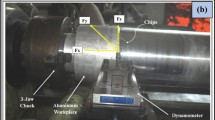Abstract
An increasing trend towards miniaturization of mechanical components necessitates the further development of micro-machining techniques in order to produce components within given tolerances. For the dressing of multilayered, metallically bonded, fine-grained grinding wheels that are used for micro-grinding the technique of electro contact discharge dressing was developed. In the following, the determined interrelations between the variables dressing voltage, limitation of dressing current, infeed and feed of electrode, and the volume flow rate in conditioning as well as the quality factor in conditioning are presented and illustrated. Thanks to the development of new geometries of CVD-diamond micro-grinding-pencils, a reduction of edge disruptions as well as a reduction of tool diameters to a minimum of 250 μm for the machining of brittle materials could be achieved. For the micro-drilling of ductile materials the maximal drilling depth could be increased by means of an adjusted process control. The smallest examined drill diameter was 50 μm. The utilizability of the developed processes and tools was proven in the production of aerostatic micro-bearings in the scope of the collaborative research center (SFB) 516.











Similar content being viewed by others
References
Denkena B, Reichstein M, Hahmann D (2006) Electro contact discharge dressing for micro-grinding. In: Proceedings of the 6th euspen international conference, Baden, Austria, Seite 92–95, 28 May–1 June
Falkenberg Y (1997) Elektroerosives Schärfen von Bornitridschleifscheiben. Dr.-Ing. Universität Hannover, Diss
Friemuth T (1999) Schleifen hartstoffverstärkter keramischer Werkzeuge. Dr.-Ing. Universität Hannover, Diss
Hesselbach J (ed) (2002) mikroPRO - Untersuchung zum internationalen Stand der Mikroproduktionstechnik. Vulkan-Verlag, Essen
Hoffmeister H-W, Hlavac M (2002) Schleifen von Mikrostrukturen. In: Feinbearbeitung im neuen Jahrtausend–Innovationen und Trends, 10. Int. Braunschweiger Feinbearbeitungskolloquium, Vulkan-Verlag
Acknowledgments
These research works have been conducted in the scope of the collaborative research centre (SFB) 516 “Design and Manufacturing of Active Micro-systems” in the particular project B3 “Micro-machining”.
Author information
Authors and Affiliations
Corresponding author
Rights and permissions
About this article
Cite this article
Denkena, B., Hoffmeister, HW., Hahmann, D. et al. Machining of micro-systems. Microsyst Technol 14, 1909–1916 (2008). https://doi.org/10.1007/s00542-008-0610-7
Received:
Accepted:
Published:
Issue Date:
DOI: https://doi.org/10.1007/s00542-008-0610-7




